|
Michael McFadyen's Scuba Diving - Land of the Giants
Fish Rock at South West Rocks on the Mid North Coast of New South Wales is a magical dive location. There are at least nine or ten different dive sites at Fish Rock, all of which would have to rate 9 or 10 out of 10.
 |
| A map of Fish Rock |
One of the most exciting sites here is the Land of the Giants. This site is located on the eastern side of the island and is the most difficult of the dive sites. It is also the one that requires certain, specific conditions to get the best of the dive. You will need flat seas and either no current or a slight to moderate current from the north. I would suggest that anything more than 1.25 knots is too strong as you will zip past the site too quickly.
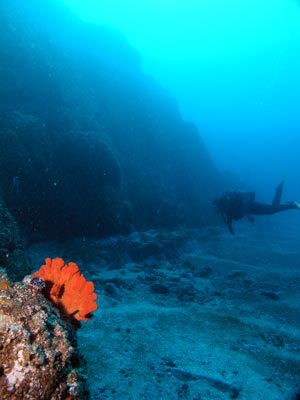 |  |
| Looking along the south-eastern corner of The Pinnacle | Two very large Queensland gropers on the main wall |
The dive begins at The Pinnacle on the northern end of Fish Rock. This is a twin peaked mountain that rises from 30 to 35 metres right up to 6 metres. GPS 30° 56.2542' S 153° 06.0481' E (using WGS84 as datum) puts you on The Pinnacle. As you descend the southern wall of The Pinnacle, you may see a grey nurse shark or two in the sand gutter below. I have seen as many as 10 here on the one dive. Do not spend too much time looking at them as there is a lot more to see and the depth means you do not have much bottom time.
Cross the sand gutter and turn east. Follow the wall that comes down from the Colorado Pass area. If you do this, after about 20 metres or so you will have a shear wall that comes down from the surface on your right. The depth on the bottom starts off at 30 metres in the gutter and gradually deepens, getting to over 40 metres at the southern end of this dive. The bottom is composed of sand with small boulders covered in sponges and sea squirts.
 | 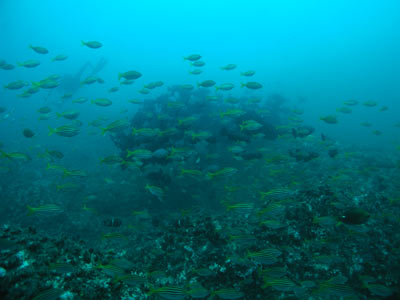 |
Looking along the main wall of
The Land of the Giants with a grey nurse shark disappearing in distance | A huge school of blackfish and mado |
Follow the bottom at first but as it gets deeper, come up off the bottom a bit. I would suggest staying at a maximum of 35 metres at first and then moving up to 30 metres. Do not linger too long deep as this is a long dive, with almost all of it deepish. This means you have limited bottom time.
Along the wall you will almost certainly see some giant Queensland gropers. In June 1999 I saw three, one about two metres long and the others a little bit smaller. In September 2007 I also saw three, two very large and one smaller. I have also seen a lot of grey nurse sharks here on some dives, but none on one. I have also seen a grey nurse shark with a deformed second dorsal fin. There are also many wobbegongs along the sandy bottom and on some small ledges on the wall.
Huge schools of long-finned bannerfish can swirl down the wall from the shallows and cross your path. Brilliant! I have had large schools of yellowtail kingfish and bream swim past us and and huge schools of black drummer and eastern rock blackfish circling us.
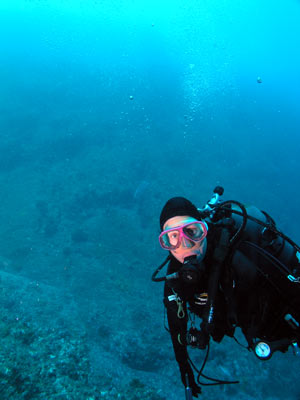 | 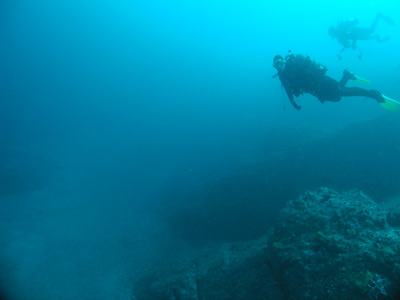 |
| Kelly on the wall of the Land of the Giants | Kelly about to cross the sand
gutter mentioned 2 paragraphs below |
This dive can end a number of ways. You can either continue on to the southern side of Fish Rock and get back on your boat at the mooring or you can circle back towards your starting point near The Pinnacle. To do the second option, you must have no current whatsoever. The first option is the better dive in my view.
If you choose the second option, once you come to a large ridge that runs down to the sandy bottom, go over this ridge/wall at the southern end of the bommie (at about 20 metres) and then move east back into Colorado Pass (the area between the bommie and Fish Rock). You will cross over a sandy basin at about 27 metres (stay at about 23 metres if you can) and which has a small cave at the northern end. From here head west or north-west and come back up to 20 metres and spend your remaining bottom time here and then on the eastern wall of Fish Rock.
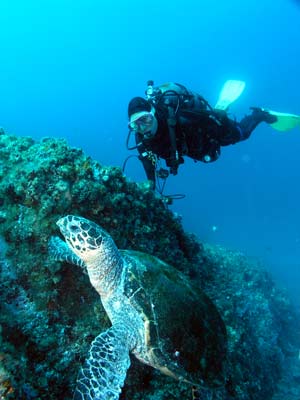 |  |
| Kelly and a turtle out at Fish and Chips | Some of the huge schools of fish at Fish and Chips |
If you decide to go to the southern end of Fish Rock, then you can follow the above directions but once you cross the sandy basin, follow the reef towards the south, with ocassional changes in direction to the west.
The alternative to this is to continue south and once the wall ends (it comes back to the sand, like a ridge - you will be at 25 metres or more), swim south-west across the sand till you hit the wall to the north of the deep end of Fish Rock Cave. For both dives to the south side of the island, follow this to the south till you can and go around it to the west into the dive site called Fish and Chips (this is east of the gutter at the deep entrance to the cave). This would be the preferred option in a stronger current. However, make sure that you do not go too far south or you will not be able to get out of the current.
Once here, head west till you see the sand gutter and then south-west across a ridge and another gutter and then a ridge. This will put you in the main shark gutter on the south side of Fish Rock. Swim along this till you find the mooring that your boat is tied up to.
 | 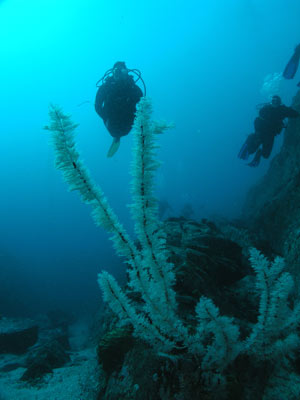 |
| Looking along the main shark gutter | Kelly behind a large black coral tree in the main shark gutter |
On this dive you will see the fish mentioned earlier as well as yellowtail, pomfrets, silver sweep, bulleyes, leatherjackets and firefish.
To get the most out of this dive, you need a current to get the fish working as well as to make the long swim easier. A current of up to one knot would be suitable, but no stronger and half a knot would be ideal. This dive is only for experienced divers who a very good on their air. With no current it will take at least 40 to 45 minutes to do this dive (including safety and deco stops). With a very slight current, you can knock a few minutes off that and with a half knot, you could probably cut five minutes off. You will certainly go into deco if you keep too low, so watch your depth all the dive.
An amazing dive, as good as any you will do in the world.
For more photos of grey nurse sharks at Fish Rock, go to the Fish Rock Grey Nurse Photo Page.
I can recommend the services of South West Rock Dive Centre. They can be contacted on 02 6566 6474, fax 02 6466 6959 or email.
| 
 v6.00.307 © 2003-2005
v6.00.307 © 2003-2005